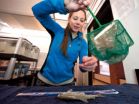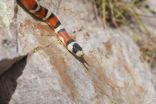(Press-News.org) NEW ORLEANS─Genetics may explain why some senior athletes are high functioning despite having one or both hip abnormalities typically associated with early onset osteoarthritis (OA): developmental dislocation of the hip (dysplasia), a loose hip joint; or femoroacetabular impingement (FAI), a condition in which the hip bones are abnormally shaped, according to new research presented today at the 2014 Annual Meeting of the American Academy of Orthopaedic Surgeons (AAOS).
In the study, "Prevalence of Radiographic Abnormalities in Senior Athletes with Well-functioning Hips," researchers evaluated the hips of 546 senior athletes (1,087 hips) with an average age of 67 (57 percent were male) for radiographic signs of FAI and dysplasia. Eighty-two percent of hips had radiographic evidence of FAI; 67 percent had at least one sign of cam FAI, in which the alpha angle of the bone was ≥50° on either hip; and 8 percent had isolated pincer impingement FAI, in which an extra bone extends out over the normal rim of the hip socket. Twenty-four percent of the senior athletes had signs of both cam and pincer FAI. Osteoarthritis was present in 17 percent of the hips. Ninety-three percent of the hips with OA had evidence of FAI, and 10 percent, dysplasia.
While hips with FAI were more likely to have OA, 72 percent of the hips with FAI showed little to no evidence of OA. According to the study authors, the findings may indicate that other factors, possibly genetics or the patient's type of cartilage, may play a role in preserving the hip joints in these high functioning senior athletes.
INFORMATION:
Genetics may explain high-functioning senior athletes with hip abnormalities
Most hips with signs of femoracetabular impingement will not develop osteoarthritis
2014-03-11
ELSE PRESS RELEASES FROM THIS DATE:
Clinical trial identifies women most likely to benefit from vaginal mesh surgery
2014-03-11
Certain women with vaginal prolapse are most likely to benefit from undergoing vaginal mesh surgery, a technique that has become controversial and is the focus of numerous lawsuits. The findings, which are published early online in Ultrasound in Obstetrics & Gynecology, provide valuable information regarding who should and should not be considered candidates for the surgery.
Vaginal prolapse—when pelvic tissues weaken and the vaginal canal may protrude through the vaginal opening—affects roughly 10% to 20% of women. A significant number of patients require repeat surgeries ...
Healthy food is good for you -- and can sell, too
2014-03-11
In the fall of 2008, the booster club in Muscatine, Iowa took a chance. Researchers from the University of Iowa asked whether the club would add healthy foods – from apples to string cheese – to its concessions menu. And, by the way, would it also consider putting healthier ingredients in big sellers like nachos and popcorn?
These were no idle requests. Booster clubs across the United States directly support schools' athletic and extra-curricular programs like band and choir. The Muskie Boosters, for instance, raise $90,000 annually for athletics and other outside school ...
Light pollution impairs rainforest regeneration
2014-03-11
These new findings were reported by scientists from the German Leibniz Institute for Zoo and Wildlife Research Berlin (IZW). The study – published in the British Ecological Society's Journal of Applied Ecology – is the first to show that seed-dispersing bats avoid feeding in light-polluted areas.
Working in Costa Rica with Sowell's short-tailed bats (Carollia sowelli), Daniel Lewanzik from the IZW gave the bats a simple choice. He divided a flight cage into two compartments. One was naturally dark and the other was illuminated by a sodium street lamp, the most common ...
Glucosamine fails to prevent deterioration of knee cartilage, decrease pain
2014-03-11
A short-term study found that oral glucosamine supplementation is not associated with a lessening of knee cartilage deterioration among individuals with chronic knee pain. Findings published in Arthritis & Rheumatology, a journal of the American College of Rheumatology (ACR) journal, indicate that glucosamine does not decrease pain or improve knee bone marrow lesions—more commonly known as bone bruises and thought to be a source of pain in those with osteoarthritis (OA).
According to the ACR 27 million Americans over 25 years of age are diagnosed with OA—the most common ...
Speed trap for fish catches domestic trout moving too slow
2014-03-11
PULLMAN, Wash.—Washington State University researchers have documented dramatic differences in the swimming ability of domesticated trout and their wilder relatives. The study calls into question the ability of hatcheries to mitigate more than a century of disturbances to wild fish populations.
Kristy Bellinger, who did the study for her work on a Ph.D. in zoology, said traditional hatcheries commonly breed for large fish at the cost of the speed they need to escape predators in the wild.
"The use of hatcheries to support declining wild salmon and steelhead is controversial," ...
Prescriptions for opioids stabilizing after fivefold increase in 10-year span
2014-03-11
March 10, 2014 -- Death rates from opioids have been soaring in the U.S. since the 1990s. To support the appropriate use of these controlled substances and inform public health interventions to prevent drug abuse, most states have implemented a prescription drug monitoring program (PDMP). In a latest study, researchers at Columbia University's Mailman School of Public Health evaluated the impact of these state-wide programs and found that after tripling until 2007, annual rates of prescriptions for opioid analgesics have stabilized although the effects of PDMPs on opioid ...
Impersonating poisonous prey
2014-03-10
EAST LANSING, Mich. — Imitation is the most sincere form of flattery – especially in the predator/prey/poison cycle.
In nature, bright colors are basically neon signs that scream, "Don't eat me!" But how did prey evolve these characteristics? When did predators translate the meaning?
In the current issue of the journal PLOS ONE, researchers at Michigan State University reveal that these color-coded communiqués evolve over time through gradual steps. Equally interesting, the scientists show how drab-colored, oft-eaten prey adopt garish colors to live long and prosper, ...
Claim that raw milk reduces lactose intolerance doesn't pass smell test, study finds
2014-03-10
STANFORD, Calif. — Some sour news for lactose-intolerant people who hoped that raw milk might prove easier to stomach than pasteurized milk: A pilot study from the Stanford University School of Medicine shows little difference in digestibility between the two.
The study was small — it involved 16 participants — but the lead investigator said the results were highly consistent among all the participants and deflate some of the claims surrounding raw, or unpasteurized, milk.
"It's not that there was a trend toward a benefit from raw milk and our study wasn't big enough ...
Small biomass power plants could help rural economies, stabilize national power grid, MU study finds
2014-03-10
COLUMBIA, Mo. – As energy costs rise, more Americans are turning to bioenergy to provide power to their homes and workplaces. Bioenergy is renewable energy made from organic sources, such as biomass. Technology has advanced enough that biomass power plants small enough to fit on a farm can be built at relatively low costs. Now, University of Missouri researchers have found that creating a bioenergy grid with these small plants could benefit people in rural areas of the country as well as provide relief to an overworked national power grid.
"Transporting power through ...
UV light aids cancer cells that creep along the outside of blood vessels
2014-03-10
A new study by UCLA scientists and colleagues adds further proof to earlier findings by Dr. Claire Lugassy and Dr. Raymond Barnhill of UCLA's Jonsson Comprehensive Cancer Center that deadly melanoma cells can spread through the body by creeping like tiny spiders along the outside of blood vessels without ever entering the bloodstream.
In addition, the new research, published March 6 in the journal Nature, demonstrates that this process is accelerated when the skin cancer cells are exposed to ultraviolet light. The husband-and-wife team of Barnhill and Lugassy collaborated ...
LAST 30 PRESS RELEASES:
Superradiant spins show teamwork at the quantum scale
Cleveland Clinic Research links tumor bacteria to immunotherapy resistance in head and neck cancer
First Editorial of 2026: Resisting AI slop
Joint ground- and space-based observations reveal Saturn-mass rogue planet
Inheritable genetic variant offers protection against blood cancer risk and progression
Pigs settled Pacific islands alongside early human voyagers
A Coral reef’s daily pulse reshapes microbes in surrounding waters
EAST Tokamak experiments exceed plasma density limit, offering new approach to fusion ignition
Groundbreaking discovery reveals Africa’s oldest cremation pyre and complex ritual practices
First breathing ‘lung-on-chip’ developed using genetically identical cells
How people moved pigs across the Pacific
Interaction of climate change and human activity and its impact on plant diversity in Qinghai-Tibet plateau
From addressing uncertainty to national strategy: an interpretation of Professor Lim Siong Guan’s views
Clinical trials on AI language model use in digestive healthcare
Scientists improve robotic visual–inertial trajectory localization accuracy using cross-modal interaction and selection techniques
Correlation between cancer cachexia and immune-related adverse events in HCC
Human adipose tissue: a new source for functional organoids
Metro lines double as freight highways during off-peak hours, Beijing study shows
Biomedical functions and applications of nanomaterials in tumor diagnosis and treatment: perspectives from ophthalmic oncology
3D imaging unveils how passivation improves perovskite solar cell performance
Enriching framework Al sites in 8-membered rings of Cu-SSZ-39 zeolite to enhance low-temperature ammonia selective catalytic reduction performance
AI-powered RNA drug development: a new frontier in therapeutics
Decoupling the HOR enhancement on PtRu: Dynamically matching interfacial water to reaction coordinates
Sulfur isn’t poisonous when it synergistically acts with phosphine in olefins hydroformylation
URI researchers uncover molecular mechanisms behind speciation in corals
Chitin based carbon aerogel offers a cleaner way to store thermal energy
Tracing hidden sources of nitrate pollution in rapidly changing rural urban landscapes
Viruses on plastic pollution may quietly accelerate the spread of antibiotic resistance
Three UH Rainbow Babies & Children’s faculty elected to prestigious American Pediatric Society
Tunnel resilience models unveiled to aid post-earthquake recovery
[Press-News.org] Genetics may explain high-functioning senior athletes with hip abnormalitiesMost hips with signs of femoracetabular impingement will not develop osteoarthritis



